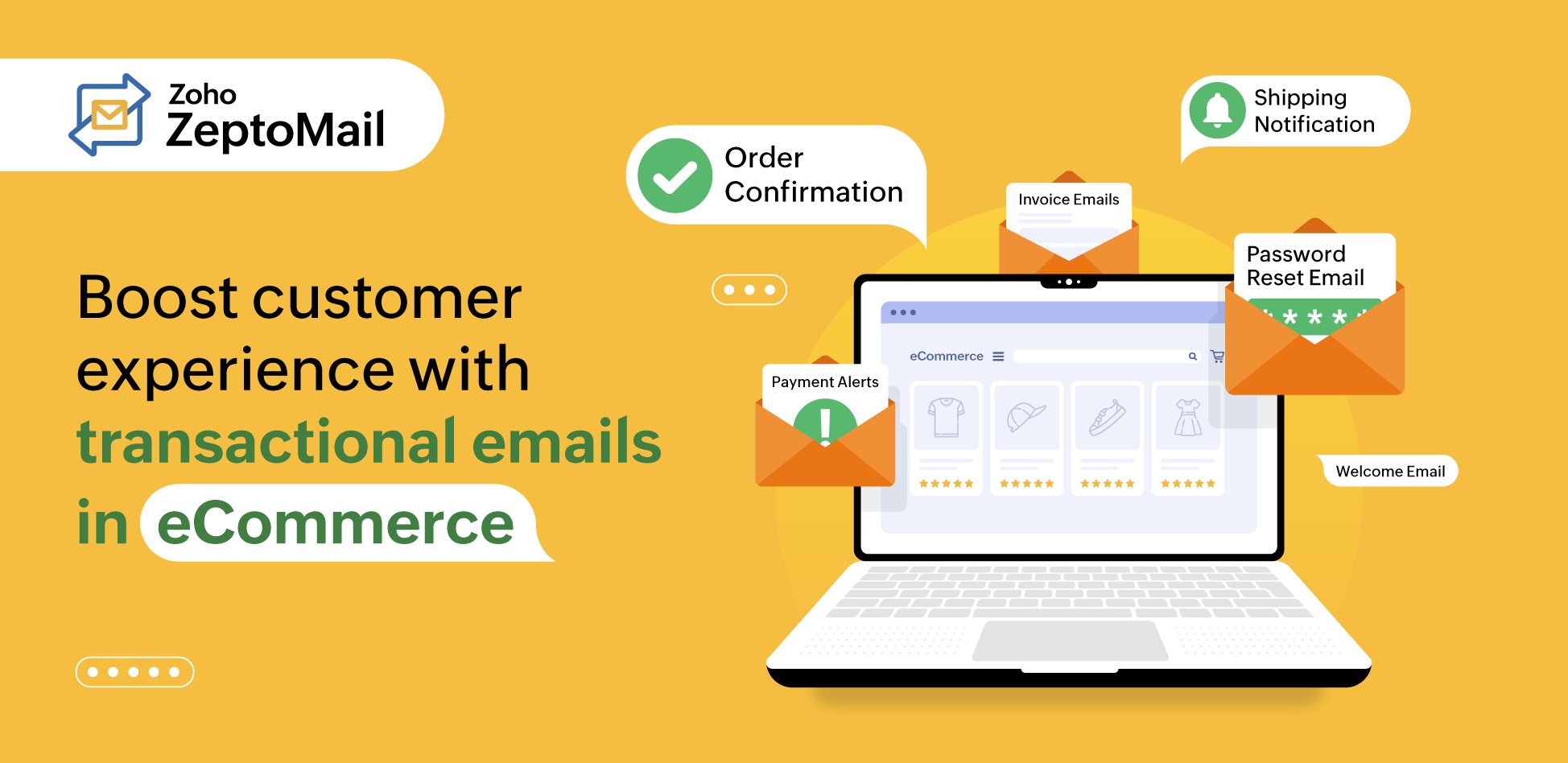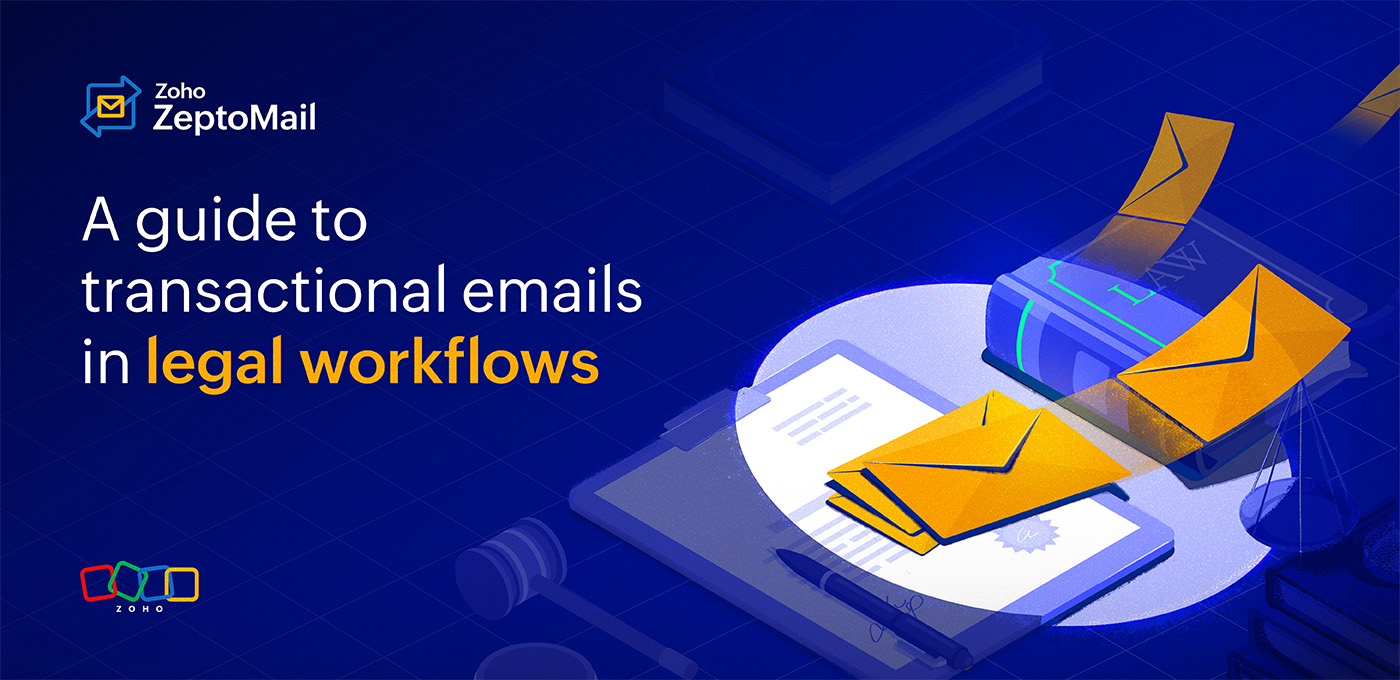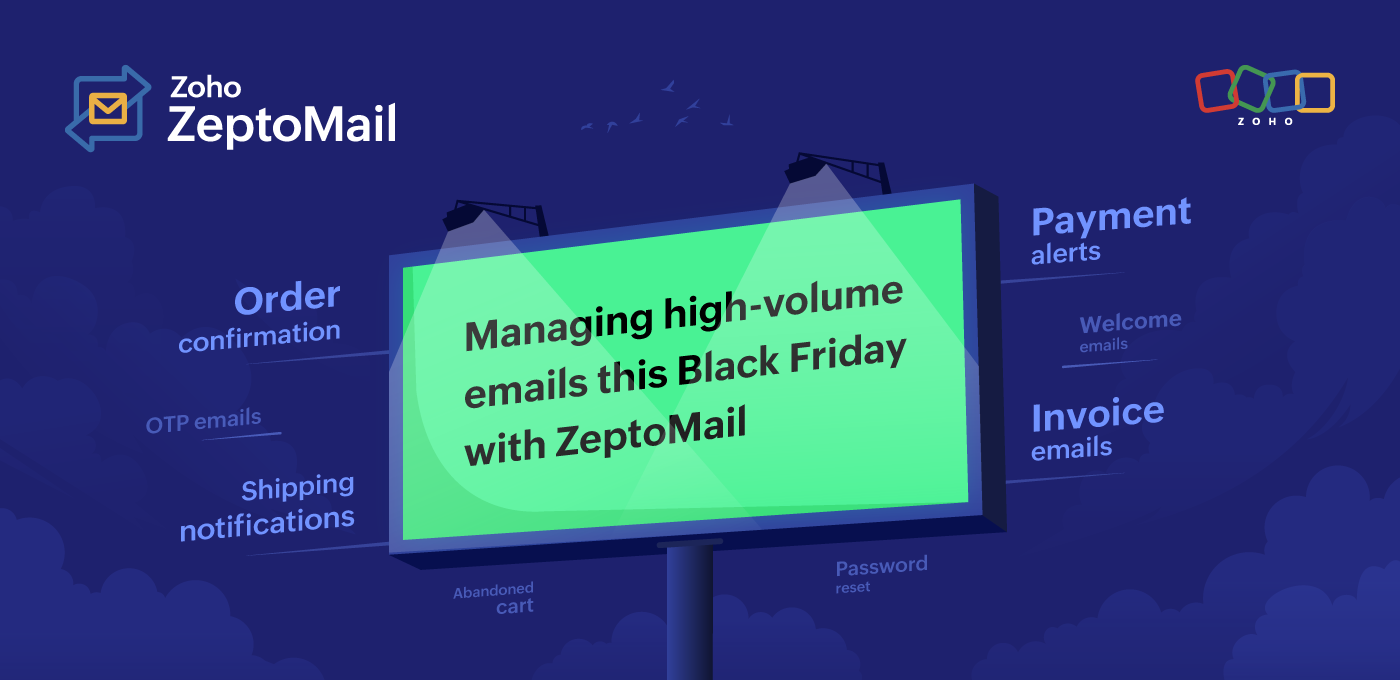Use transactional emails to ensure good customer experience for your eCommerce business
- Published : April 3, 2024
- Last Updated : September 16, 2025
- 551 Views
- 12 Min Read
Technology has brought so much convenience into our everyday lives. Everything is available right at our fingertips in our electronic devices. Everything from expensive electronics to groceries is available for purchase online. This is the eCommerce industry. It refers to any entity that sells products or services online.
As a customer, this is the industry that we come across and use on a regular basis. In eCommerce, every purchase involves a payment (among other things), making every purchase a transaction. These transactions need to be acknowledged by the retailer or service provider in some form.
The most common and official form of this communication is an email. More specifically, emails triggered by a user’s transaction with the eCommerce business are called transactional emails. Common examples of these emails are order confirmations, shipping notifications, delivery notifications, subscription confirmations, invoices, receipts, and more.
These emails are unique to each user, triggered by their action, and often carry important information about the transaction itself.

Importance of transactional emails in eCommerce
Transactional emails are important for any business, but the importance is more pronounced in the case of eCommerce.
Good customer experience
Ensuring a good customer experience (CX) is of utmost importance in the eCommerce industry, where the business serves consumers directly.
Imagine that you walk into a muffin shop and place an order, but you receive no response from the person behind the counter. You don't know if they heard you or if you're getting your chocolate muffin. Would you want to buy again from that shop? Probably not.
When it comes to eCommerce, failing to send the transactional email in response to a user’s action will lead to a similar experience. A well-crafted and delivered transactional email can ensure a good customer experience.
Communicates information
Ensuring that information reaches your customer when they expect it is crucial. One survey found that 60% of online shoppers surveyed checked their order status every day, and 17% checked more than once per day. Now imagine your business not delivering shipping notifications or tracking details to the user. Transactional emails are important especially in the eCommerce industry to maintain the flow of information between businesses and the user throughout the user journey.
Offers high engagement
Keeping in touch with consumers is important for all eCommerce businesses. This doesn’t mean bombarding them with marketing emails. Marketing emails aren’t requested by the users like transactional emails are, so transactional emails come with much higher open rates. Getting the delivery of these emails with high engagement rates help fortify your relationship with consumers.
Authenticates the transaction
Say you're making a purchase on an eCommerce site. Once you hit the button to place the order, you'll find yourself waiting for the 'Order placed' email containing the details of that order. Receiving that email is a sign that the order you've placed has gone through successfully. Especially in eCommerce, where users are spending money online for a product or service, they want and need assurance that the transaction they just made is authentic. Transactional emails are important to convey this assurance.
Helps customer retention
Happy customers are loyal customers. Delivering important emails well can help businesses build credibility with users by providing them peace of mind about their purchase. The post-purchase experience is key to retain customers. If they’re left hanging once they've given you their money, even if they get what they paid for, they will decide that it’s not worth the hassle to order from you again. Send transactional emails whenever required after the purchase to retain customers and encourage repurchase.
Reduces support tickets
"Where’s my order?" is probably the most common subject of support tickets received by eCommerce businesses. These are closely followed by the subject "Need an update." You can reduce a huge chunk of these support tickets by delivering transactional emails at each post-purchase step of the user journey. A simple shipping notification with a tracking link can save your team tons of angry or worried emails and calls from upset customers.
Offers upsell opportunity
While transactional emails are meant to be strictly about the transaction at hand, businesses can still use these high-engagement emails to upsell. Cramming in marketing content can reduce the deliverability of transactional emails and defeat the purpose of these emails altogether, but businesses can use these emails wisely by including relevant content that could lead to upsell. For example, a link to other similar products in an order confirmation email is still within the context of the email. This has to be done without overwhelming the customer or jeopardizing the deliverability of the emails.
Key challenges for the eCommerce industry
Reliable email delivery
The foremost challenge is guaranteed delivery of transactional emails. The email is triggered by an action, and the user is waiting for it. Failing to deliver these emails or delivering them to the spam folder can be a terrible look for your business. This requirement is of utmost importance to ensure reliable delivery.
Fast delivery
Transactional emails can be time-sensitive, like an OTP email or password reset email. Delivering them late can make the user lose trust in your business. Even if the email is not time-sensitive, not delivering them instantly after the action is performed can make the consumer panic and negatively impact the post-purchase experience.
Secure emailing
Transactional emails contain information about transactions made by the customer. Whether it’s important information like payment details or a simple order list, it’s personal to the customer, and the business has a duty to protect it from unauthorized parties. Along with ensuring good delivery, businesses have to ensure that the email is secure while being sent.
Comprehensive analytics
With transactional emails being this crucial to your eCommerce business, you should have access to detailed analytics and reports about the delivery. This will help you gather insights about how you can improve the delivery of these emails. It will also allow you to take immediate corrective measures to troubleshoot any possible issues that might arise.
Scalable email service
A single customer can make multiple purchases, and each purchase comes with at least half a dozen transactional emails associated with them. Other than these, there are other transactional emails associated with the account itself. Now compound this across your entire customer base. It's a huge volume of transactional email. You need an email service that’s scalable to manage the increasing volume as your business grows.
Choosing the right provider to trust your transactional emails with can help you overcome all of these challenges. Zoho ZeptoMail is one such email service that focuses exclusively on transactional email delivery, allowing your business to ensure reliable, secure and speedy delivery. Our interface comes with user-friendly analytics that allow you to track the emails’ performance.
Best practices for transactional emails in eCommerce
Authenticate your domains
The first step in securing good deliverability for your emails is authenticating your email sending domain with all of the appropriate DNS records. Ensure that SPF, DKIM, and DMARC records are correctly published for your domains. This is a sign for recipient servers (your customer's email server) that your email and you as a sender are trustworthy and can be allowed into the inbox.
Craft an appropriate 'From' and subject line
The From name and the subject line are the first impression of your email. The sender name should have a name along with your business name to familiarize. The subject line should be direct and convey the purpose of the email you send. The subject line and the From name could be the difference between your users taking the email seriously or not.
Create concise content
The content of transactional emails should be to the point. Transactional emails usually have a singular purpose. Craft content that focuses entirely on this purpose and doesn’t overwhelm the customer with too much information. Burying the lead can lead to a bad experience for the customer.
Use a brand-aligned design
Your transactional email should be designed to reflect your brand for two reasons. First, it helps your users identify your authentic emails from among the flood of emails in your inbox. This will help with engagement and deliverability. Second, it builds brand identity. An email that carries the personality of your brand will help familiarize you customers with it.
Insert useful links
Though the email content itself should focus on its primary purpose, you should include links to helpful and relevant resources or pages. For example, you can link your social media profiles, contact page, or order history page. It will help them in their user journey and to navigate your platform with ease.
Avoid no-reply addresses
Sending transactional emails from a no-reply email address was once common and was a way for businesses to manage email traffic. But it’s no longer advisable. It tells the user that your line of communication isn’t open and can look like a bad attitude to carry. Additionally, no-reply email addresses can be detrimental to your transactional email's deliverability as well.
Set expectations
Letting the user know what they can expect after they’ve performed an action can help provide a better customer experience and keep the user informed so they don’t mistake the email for spam. A simple message that reads, "Thank you for your purchase. You will receive an email with order details," is all it takes.
Give the user control
While transactional emails are essential emails, the user might not wish to receive one at every turn. Allow space for the user to manage the non-critical notifications so they can choose which emails they receive. This could cut down any spam complaints you might be receiving simply because your users have no other way to stop the emails.
Don’t over-promote
With such high open rates, it’s tempting to include marketing content in transactional emails. But overwhelming the user with marketing content when all they need is their tracking link or invoice is counter-productive. It doesn't make for a good experience and can simultaneously trigger spam filters that cause your deliverability to decline.
Build responsive emails
The number of users that access emails from different devices is highest in the eCommerce industry. Consumers can dig out their mobile device to quickly click on the tracking link while traveling or log in to their browser to check their order status in the middle of the workday. Your emails have to be rendered well across devices, browsers, and clients so you can provide a good experience and not be mistaken for a broken spam email.
Protect your users’ data
Data protection has two layers. First, ensure that you have updated encryption in place to protect your customer's data transmitted through the email. Second, make sure to comply with data protection laws. These laws can vary based on the country or region your customer is in, but it’s in the best interest of your customers and your business to follow these laws.
Separate your transactional emails
Marketing emails and transactional emails both serve different purposes, but with marketing emails not being requested by users, they run the risk of being marked as spam by the user or the recipient server. Sending transactional emails from the same service can negatively impact the deliverability of these emails, too. If you want great deliverability for your transactional emails, it’s best to employ an email service separately for transactional email sending. Zoho ZeptoMail doesn’t allow marketing emails to be sent from our platform, making it the perfect choice to ensure good deliverability for your emails.
The top 10 transactional emails you should send in eCommerce
Verification emails
Welcome emails
Educational emails
Order confirmations
Shipping notifications
Password reset emails
Invoice emails
Abandoned cart emails
Payment alerts
Feedback emails
1. Verification emails
Verification emails are generally a double opt-in method where the customer has to verify their email address before fully using your eCommerce platform. It allows your business to make sure that you have the right email address. Sending emails to the wrong email address can make your sender reputation take a hit.
Best practices for verification emails:
Inform the user that they’ll receive the verification email after they sign up.
Make the verification CTA stand out.
Clearly mention the platform they’re verifying their email address for.
Provide them with ways to reach your team in case of queries.
2. Welcome emails
A welcome email is often the first communication from your business. A perfect welcome email can set the tone for your relationship and leave a good impression with the customers.
Best practices for welcome emails:
Include account details in the email.
Make sure that the email conveys a brand story.
For longer messages, include a link to videos.
Clearly mention the next steps they can take.
Don't be too product-focused.
Don’t share plain-text credentials in the email.
Read our article on best practices for welcome emails for a detailed list of do's and don’ts.
3. Password reset emails
A password reset email is one of the most common transactional emails that a consumer receives. It’s especially high in eCommerce. Consumers are used to having their passwords saved in their browser or mobile app. It increases the chance of them needing password recovery. This email is especially important because it helps them regain control of their account.
Best practices for password reset emails:
Never send the password in the email.
Ensure that the email is delivered instantly.
Mention the account for which they’re resetting the password.
Include a plain-text version of the email.
Set a safe expiration time for the email link.
Inform the user of the steps to take if they didn’t request the email.
Read our article on best practices for password reset emails for a detailed list of do's and don’ts.
4. Educational emails
You can set up educational emails based on your customer's activity on your website to help them along in their journey. These emails can be especially useful in nudging increased use among new customers.
Best practices:
The content shouldn’t come across as demanding.
Include an incentive to complete the next step.
Give clear instructions of the process you wish them to undergo.
Highlight the benefit of following the instructions.
5. Order confirmation emails
This email is the most common in eCommerce. With the entire industry revolving around online purchases, order confirmations are essential. They play a key role in the post-purchase experience that could decide if the user will repurchase.
Best practices:
Give details about the order placed.
Mention the payment method and other relevant details.
Include information about the shipping timeline.
Provide a way to navigate to the orders page in your account.
Give them ways to contact customer support.
6. Shipping notification emails
This email is important for all eCommerce businesses dealing with physical products. Informing the user of the progress of their purchase will give them peace of mind and ensure a much better customer experience. Your business will also receive much fewer support tickets about order whereabouts.
Best practices:
Include details of the item ordered.
Inform the user of the order status.
Mention an estimated date of delivery.
Include the shipping address.
7. Invoice or payment receipt emails
Purchase receipt emails act as a proof for payment from the customer. In some cases, these emails might even be used as proof at a later point. They’re serious emails and must be dealt with accordingly.
Best practices:
Mention clearly which purchase the invoice is for.
Attach a downloadable copy of the invoice.
Include the date of the purchase.
Provide your contact information.
8. Abandoned cart emails
Abandoned cart emails are an excellent way to re-engage with the user. In spite of the intent encouraging users to check out, they’re still transactional emails because the email is triggered by the user adding items to the cart. These emails are a great way to retain customers.
Best practices:
Emphasize the benefits of the product or the purchase.
Include social proof, like testimonials, about the product.
Give them incentive to complete the purchase.
Don’t wait too long after the action to send the email.
9. Payment alert emails
These emails are sent to remind customers of pending payments or upcoming renewals. Modern life is busy, and it’s common for users to lose track of payments. Payment reminder emails can cut down the hassle of having to remember details and due dates, and help ensure that customers are retained by extending your relationship.
Best practices:
Give details about what the payment is for.
Mention the due date for the payment.
Include the amount that has to be paid.
Display clear and simple options of payment.
Make the payment process from the email as easy as possible.
Send the email as soon as possible so users have time to make the payment.
10 . Feedback emails
These emails are another important part of the post-purchase experience. Customers generally have a better impression of a business when they feel heard. This is especially true in eCommerce because it deals directly with customers. An email asking for feedback about the purchase and the experience is a great way to make them feel heard and gather insights for your business.
Best practices:
Make the review process as simple as possible.
Give them an option for a short review and a detailed review.
Let them know upfront that it won't take long.
Give them incentive to share the review.
Only include necessary questions.
Email service for eCommerce businesses
While picking an email service to send transactional emails from your eCommerce business, ensure that it’s equipped with all of the tools to overcome the challenges we’ve discussed. Picking the right email service can help tick a lot of the boxes in this list. With transactional emails being crucial for customer satisfaction, choose an email service who prioritizes transactional email delivery instead of thinking of it as an add-on.
Zoho ZeptoMail is an email service that was built with the singular purpose of sending transactional emails. ZeptoMail's delivery is optimized for transactional emails and always prioritizes reliable and timely delivery. Read more about how Zoho ZeptoMail can be used by eCommerce businesses here.


